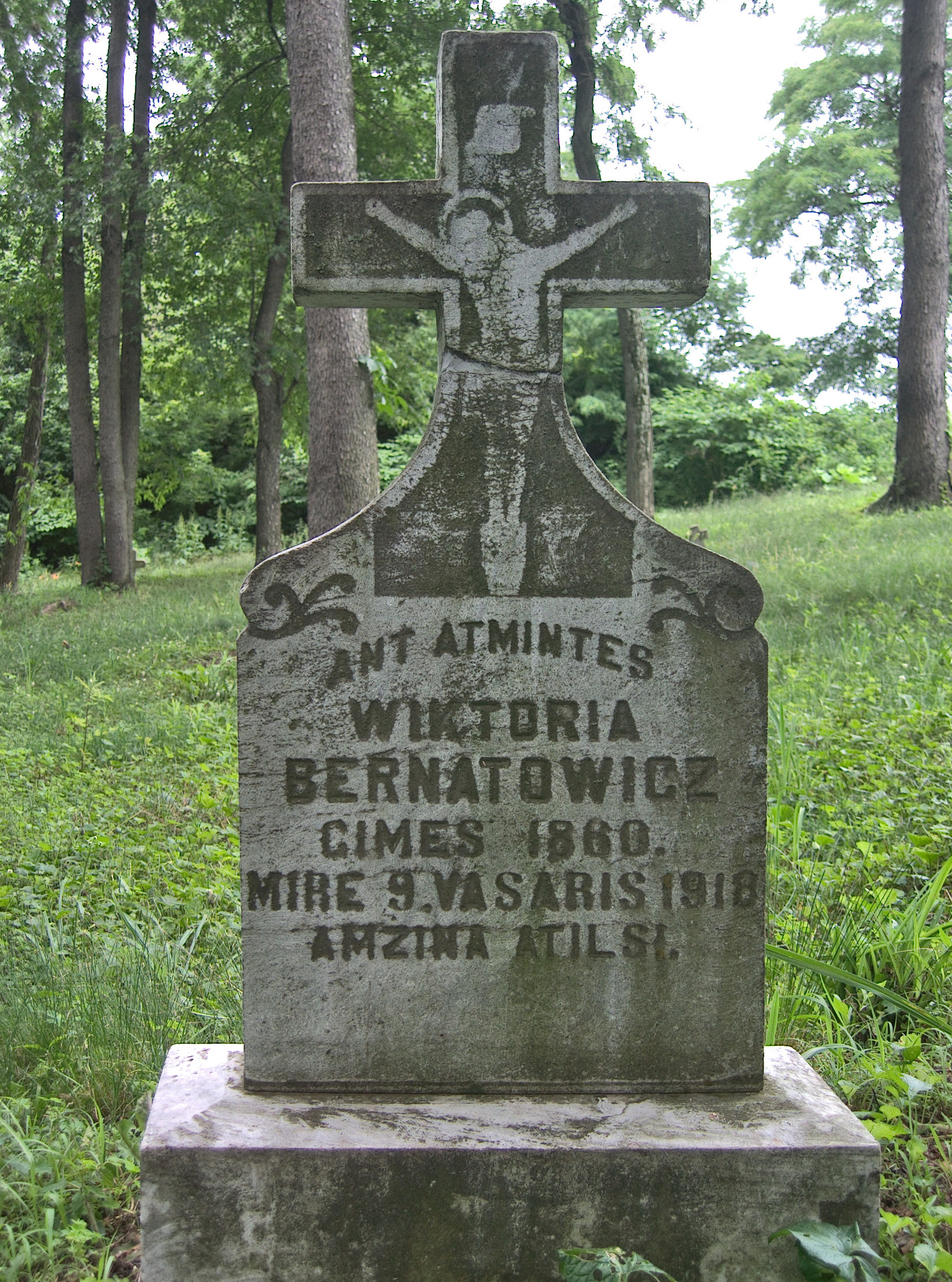According to the cemetery’s Web site, this is probably the monument for Verlinda Stevens, who died in 1872. The marble is so badly eroded that we cannot read any of the inscriptions, but even—or perhaps especially—in this state it is quite picturesque.
-
-
Wiktoria Bernatowicz Tombstone, St. Adalbert Cemetery
A Lithuanian tombstone in a good state of preservation. European immigrants tended to bring with them their memories of what a gravestone should look like, so we find very different styles in different ethnic groups. This is a common East European style. The East European tombstones here were often decorated in very shallow relief, much of which has vanished in a century or so of erosion; but this crucifix is still visible in outline, though the details are lost.
With the help of Google Translate, here is the inscription:
IN MEMORY OF
WIKTORIA BERNATOWICZ
BORN 1860
DIED FEBRUARY 9, 1918
ETERNAL REST
-
Andrew M. Russel and Andrew Russel, Sr., Tombstone, Oak Spring Cemetery
A simple rectangular stone is unusual in this era. This stone commemorates two Andrew Russels (note the spelling of the name). The first died in 1808 at six years old. (If a tombstone says “in the xth year of his age,” it usually means the deceased was x years old, though technically an x-year-old is in the x+1 year of his age.) The second died in 1814 at 82 years old, so he was probably a great-grandfather of the first.
Father Pitt believes that this stone was put up in 1808, and the inscription for Andrew Russel, Sr., added in 1814. His evidence is, first, the word “Also,” and second, a demonstrable difference in the styles of lettering between the two inscriptions. The second is well matched to the first, but probably by a different hand, one that made thinner letters—or possibly by the same stonecutter after six more years of practice.
IN MEMORY OF
ANDREW M. RUSSEL
who died
Feb,y 27th 1808;
in the 6th year of his age.
—
ALSO
ANDREW RUSSEL, Senr
died
June 20th 1814;
in the 82nd year of
his age.
-
Jacob, Elizabeth, and Charity Bell Tombstones, Chartiers Hill Cemetery
 Three different burials in the same family plot show us three different styles of early-settler tombstones.
Three different burials in the same family plot show us three different styles of early-settler tombstones.Jacob Bell lived the longest of the three: he was buried in 1842. Shortly after that, local stonecutters would begin to be replaced by more centralized businesses, so this is one of the last of what Father Pitt would call the early-settler tombstones. It does not seem as elegantly cut or proportioned as the earlier tombstones, which makes us wonder whether the stonecutter’s craft was already fading. The inscription reads:
SACRED to the MEMORY OF JACOB BELL, Who departed this life, Nov. 18th 1842 in the 75th year of his age.
 Elizabeth Bell, Jacob’s “consort” (the stonecutters’ preferred term for “wife”), died in 1829, and her tombstone is typical of the time. It is not as elaborately cut as some other 1820s tombstones, but compare it to Jacob’s and see how much better formed the individual letters are, and how much more carefully laid out the lines are in the inscription.
Elizabeth Bell, Jacob’s “consort” (the stonecutters’ preferred term for “wife”), died in 1829, and her tombstone is typical of the time. It is not as elaborately cut as some other 1820s tombstones, but compare it to Jacob’s and see how much better formed the individual letters are, and how much more carefully laid out the lines are in the inscription.IN Memory of ELIZABETH BELL, Consort of JACOB BELL Who departed this life January 13th A.D. 1829 in the 58th year of her age.
Finally, Charity Bell, who was probably a daughter of Jacob and Elizabeth, died in 1832, and was given a tombstone of the Gothic shape popular in the 1830s. The lettering is done very well (non-standard spelling of the month notwithstanding), and the stonecutter has added the tree ornament—probably intended as a weeping willow—that we commonly see on early-settler tombstones.
IN MEMORY OF CHARITY BELL Who departed this life Aprile the 6th A.D. 1832 in the 35 year of her age







